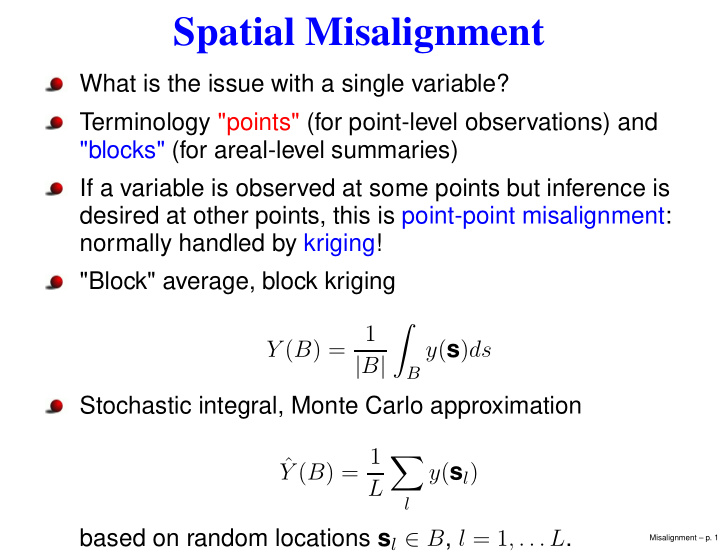



Spatial Misalignment What is the issue with a single variable? Terminology "points" (for point-level observations) and "blocks" (for areal-level summaries) If a variable is observed at some points but inference is desired at other points, this is point-point misalignment: normally handled by kriging! "Block" average, block kriging 1 � y ( s ) ds Y ( B ) = | B | B Stochastic integral, Monte Carlo approximation Y ( B ) = 1 y ( s l ) ˆ � L l based on random locations s l ∈ B , l = 1 , . . . L . Misalignment – p. 1
Block-Block Misalignment Population by census tract; residential structures by “cell”: by cell Misalignment – p. 2
Misalignment cont. Here a variable is observed at block level (say, census tracts) with inference desired at other blocks (say, the cells of the exposure “windrose”) In the geography literature, this is known as the modifiable areal unit problem (MAUP) Hierarchical modeling preferred to ad hoc “areal allocation” (i.e., simply allocating counts proportional to the area of the subregions formed by the intersection of the two grids) Finally, what if the variable is observed at block level, but inference is sought at point level? Does this make sense, e.g., average rainfall for B down to rainfall at a point vs. percentage of smokers in B down to percentage of smokers at a point. Misalignment – p. 3
Bivariate misalignment Ozone measurements at fixed sites; counts of pediatric asthma cases by zip code in Atlanta, GA: Misalignment – p. 4
Bivariate misalignment issues When we have two spatially referenced variables, interest often lies in spatial regression. But what if the two variables are misaligned: X at point level, Y at other points X at point level, Y at block level X at block level, Y at point level X at block level, Y at a different block level Improvement over ad hoc approaches; getting the uncertainty right Solution: Bring the X’s to the scale of the Y’s, then fit the model (BCG book, Sec 6.4) With more than two variables, bring all the variables to a common scale. Highest resolution is obviously preferred. Misalignment – p. 5
Recommend
More recommend